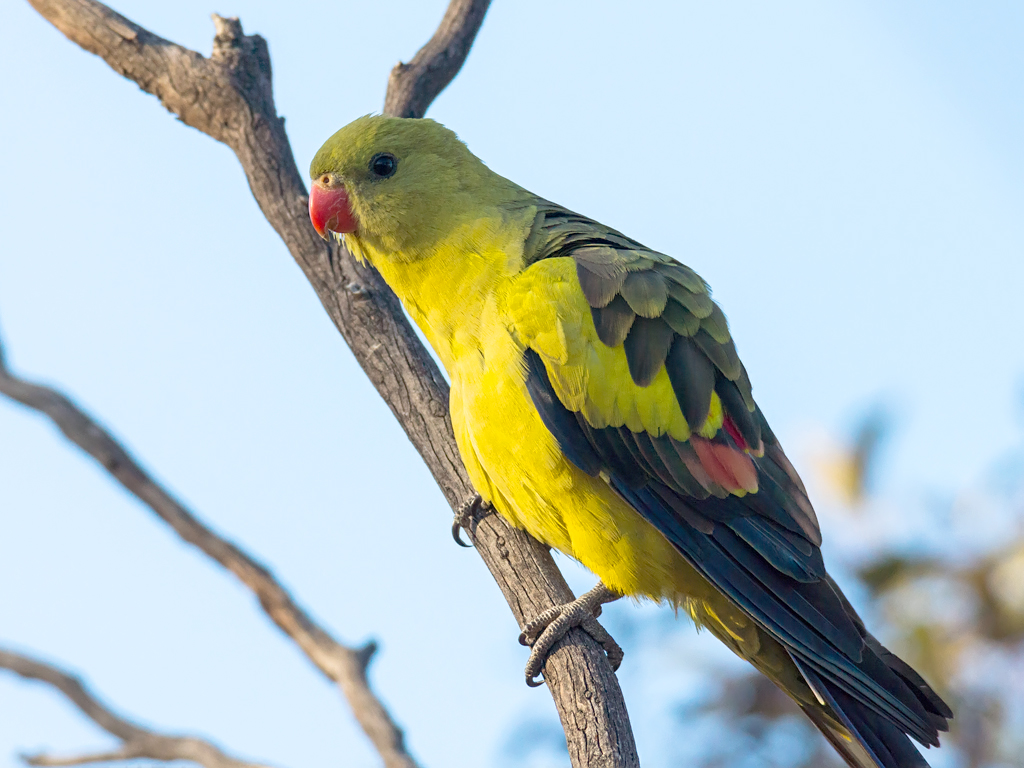When not breeding, Regent Parrot (Polytelis anthopeplus) gathers in flocks of 15 to 100 for communal roosts in the taller gum trees along streams and around farm dams.
Early in the morning, they can be seen preening and chattering on the highest branches. Following that, they often travel many kilometers to drink and feed. It usually feeds on seeds, fruit, blossoms, and shoots; grain and cultivated fruit are sometimes exploited as well. Regent parrots spend most of their day on the ground, or sometimes in trees and shrubs. By dusk, they are flying back to their roosts and drinking only sporadically.

Using steadily beating wings, the Regent Parrot flies very swiftly, gracefully, & directly. In breeding, the males form small groups to feed, leaving the females in charge of incubating and brooding. Although the males of the parrot tend to be more attentive to their mates, roosting close to the nest, rarely leaving it for food, and regurgitating food for the female throughout the day, they will still pay close attention to their mates.
Consequently, the pair does not preen each other before laying, but courtship feeding by the male begins weeks before the laying takes place. It has a similar display to the Superb Parrot, but it is less elaborate. Grass and plant seeds are the main food sources, especially wheat crops. Insect larvae, psyllids, lerps, and buds are also eaten by it. In addition to Smoker, Rock Pebbler, and Marlock Parrot, this parrot has several other names. Including its long tapering tail, Regent Parrots are about 400-450mm long.
Bright yellow underparts and the head of the male Regent Parrot are characteristic of the species. The crown and nape of Western Australian males are much duller yellow and olive-toned. It is olive-green on the mantle and back, and yellow on the rump. Additionally, the red band on the inner and outer wing coverts and secondaries; blue-black coverts on the outer wing coverts; and bright yellow shoulder.

Dark blue is the color of the outer web of primary and secondary webs. There is a rich yellow color on the underwing coverts. There is nothing special about the tail except it is blue-black in color. On the bill, orange-brown eyes and orange-coral cere are visible. Mid-grey is the color of the feet and toes.
Female Regent Parrots have dull olive-yellow heads and breasts; their backs are dull green. The wings are like those of the male, but they are a little duller; the median wing coverts are yellow. There is also a dull olive-green color on the undertail coverts. It has a dark blue-green tail, with outer tail feathers edged and tipped in pink on the underside.
It is similar to the adult female parrot when it is immature. Males have yellower tinges on their heads when they leave their nests. When a chick reaches the age of 14-15 months, he or she attains full adult plumage. There is a white-downed, dull-billed young Downy.
Regent Parrots give a harsher call in flight than the Superb Parrot, similar in sound but harsher in pitch. A soft Twitter is heard after the bird alights.
The nesting and breeding season is between August and January. Nests are typically built in large hollows along trees’ main trunks and built with a bed of wood dust.
Eggs usually measure 31-32 x 24-25 mm and are white; rounded in shape. A bird normally lays four to six eggs per clutch. There is a 21-day incubation period for females. About six weeks after hatching, the young parrot fledges.
In southwestern Australia, there are two isolated populations of Regent Parrots. One lives in mallee wheat belts; the other lives along the central Murray River between Robinvale and Morgan in southeast Australia. A nomadic race that breeds in river gums on the Murray system and wanders widely through surrounding mallee when it is not breeding.
These Regent parrots have been reported to live up to 27.5 years in captivity, though that has not been verified; and they can breed starting at about one year of age. The regent parrot belongs to the parakeet family and is one of the most attractive birds. It is easy to imagine these parakeets getting along with other animals and becoming friends because of their loving nature, their active personalities, and their pleasant demeanor.
Read More – Crimson Rosella Life Spans, Call, and More







